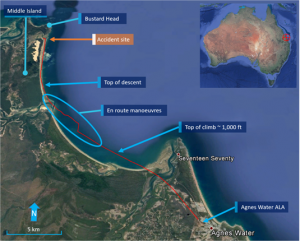“Prepare to land straight ahead following a low-level power loss” – ATSB

Pilots should plan to land straight ahead when conducting an emergency landing following an engine failure or power loss at low height, as reinforced by a new Australian Transport Safety Bureau (ATSB) investigation
One passenger was fatally injured and two other passengers and the pilot were seriously injured when a Cessna 172 operating a passenger charter flight suffered a total power loss at a height of about 60 feet while assessing a beach landing area to ensure it was suitable for a planned landing.

After conducting initial engine checks, the pilot had elected to conduct a “significant” left turn to the beach, the investigation into the January 10, 2017, accident at Middle Island, Queensland, established. During the continued turn, the aircraft impacted the beach with little or no control and at a significant descent rate.
Despite a detailed inspection of the engine and related systems, the ATSB was unable to identify the reason for the loss of engine power. Nevertheless, the ATSB found that the operator’s procedures and practices for conducting airborne inspections of the Middle Island airplane landing area (ALA) did not effectively manage the risk of an engine failure or power loss when at a low height.
The operator’s inspections were generally flown at 50-100 feet above sea level while flying at normal cruise speed towards an area of water at the end of the beach, with no planned consideration of what to do in the event of an emergency.
“Regardless of the reasons why it occurred, an engine power loss should not necessarily lead to catastrophic consequences, even in a single-engine aircraft.”
“This tragic accident reinforces standard pilot training and guidance that, following an engine power loss at a low height, an emergency landing should, in most cases, be planned straight ahead with only small changes in direction to avoid obstructions,” ATSB Chief Commissioner Greg Hood said.
“Operators and pilots should review their flight procedures to ensure that straight-ahead emergency landings are possible when their aircraft are at a low height. If such landings are not possible, then the suitability of the flight should be evaluated.”
Mr Hood also stressed that operators and pilots that conduct airborne inspections of landing areas should also ensure that the risk of an engine failure or power loss is considered when planning and conducting such inspections at a low height, particularly when below 500 feet.
The ATSB investigation noted that all options facing the pilot after the power loss were likely to result in at least some level of damage and/or injury
The investigation also noted that the option likely to result in the least damage or injury was to land the aircraft ahead on the remainder of the beach heading north.
ATSB’s investigation found a number of other issues with the operator’s activities, although these were not found to be contributing factors to this accident.
These included:
- under-recording of aircraft flight hours,
- the aircraft being overweight for the accident flight with baggage and supplies not effectively secured,
- issues with the operator’s calculations of weight and balance,
- and the conduct of near-aerobatic maneuvers during passenger charter flights with limited controls in place to manage the risk of such maneuvers.
“Broadly speaking, the operator had no effective assurance mechanisms in place to regularly and independently review the suitability of its activities,” Mr. Hood said.
The accident also identified a number of issues regarding occupant survivability, including the lack of upper torso restraints (seatbelts) for rear-seat passengers, not briefing passengers on the brace position and the non-carriage of life jackets. It also found further scope for the Civil Aviation Safety Authority (CASA) to improve its surveillance activities of small operators.
Read the final ATSB report.
Founded in 1988, the TapRooT® Root Cause Analysis System
solves hurdles every investigator faces
TapRooT® Root Cause Analysis Training System takes an investigator beyond his or her knowledge to think outside the box. Backed with extensive research in human performance, incident investigation, and root cause analysis, TapRooT® is a global leader in improved investigation effectiveness and productivity, stopping finger-pointing and blame, improving equipment reliability, and fixing operating problems.
System Improvements, the creator of the TapRooT® System, has a team of investigators and instructors with years of extensive training ready to offer assistance worldwide. We also offer ongoing support to our clients through free newsletters and root cause tip videos, the root cause analysis blog, and our annual Global TapRooT® Summit.
Register for a TapRooT® Course
Register for one of our TapRooT® courses. We offer a 2-Day TapRooT® Root Cause Analysis Course and a 5-Day TapRooT® Advanced Root Cause Analysis Team Leader Course. Contact us or call us at 865.539.2139 about having a course at your site or for further root cause analysis training opportunities. We’re here to help you find solutions.

Don’t forget to register for the 2020 Global TapRooT® Summit
Register today for the 2020 Global TapRooT® Summit. Make your plans to hear and learn from well-known, incredible speakers and network with industry leaders!



